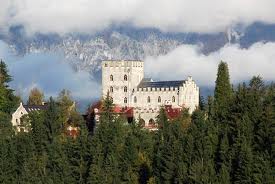

Location: 20 km west of Kitzbühel, Tyrol Map
Itter Castle is a medieval castle situated 20 km west of Kitzbühel, Tyrol region of Austria. In a strange twist of history Itter Castle became a site where German Wehrmacht fought shoulder to shoulder with the American GIs.
Itter Castle was first mentioned in the official documents that date back to 1240. However original fortress date back to the 10th century to guard an entrance to Brixental Valley. At the time it was a small central tower to keep an eye on the surrounding lands rather than prevent a massive invasion.
Itter Castle sits on top of the strategic mountain at an elevation of 666 metres (2,185 feet) above the sea level overlooking the Brixental Valley. It belonged to the bishops of Salzburg between 1312 and 1816 when it became part of Tyrol province of the Austrian Empire (later Austro- Hungarian Empire). Itter Castle was baught in 1884 by Sophie Menter, pianist, composer and student of famous composer Franz Liszt. Another famous Russian composer Pyotr Ilyich Tschaikovsky visited Itter Castle and ever personally orchestrated some of his compositions in 1892.
The time when the castle was built is unknown. It was a border
fortress of the Bishopric of Regensburg to monitor the entrance to
the Brixen Valley against the Prince Archbishopric of Salzburg and
could have been built after 900 (902 the Brixen Valley came to
Regensburg), but maybe later. In 1380 Itter was sold to Salzburg by
the Regensburg cathedral chapter; the first known documentary
mention comes from 1241 (together with Dorf Itter and Count Palatine
Rapoto II of Ortenburg as lords of the castle).
In the 14th
century, the Itter court and caretaker were based at the castle, the
castle and village were set up as a truce, which meant for the
population not only the supply of firewood and food to the
administrative center, but also the construction of roads and the
deployment of military contingents.
In 1526 the castle was
destroyed in the peasant uprisings by Pinzgau farmers, but was
rebuilt in 1532. In the last years of the 16th century the castle
housed an ecclesiastical court dealing with the prosecution of
witches. In the following centuries, the castle changed hands
several times and belonged to Emperor Josef II from 1782. In 1805 it
was taken over by Napoleon Bonaparte, who gave it to King Maximilian
I of Bavaria in 1809. The Bavarian government left the building,
which has since fallen into disrepair, to the municipality of Itter
for a symbolic construction fee of 15 guilders. The villagers used
the ruins as a source of building materials.
In 1878, Paul
Spieß, an entrepreneur from Munich, bought the area for 3,000
guilders. He had today's castle built on the foundations. As a
result, a guesthouse with 50 rooms was set up - unsuccessfully. In
1884 the pianist Sophie Menter acquired the property, and Liszt and
Tchaikovsky, for example, were guests here. In 1902 a new owner,
Eugen Meyer, had the building rebuilt in a neo-Gothic style with
hints of the Tudor style. Under these owners, the building was
equipped with electric lights and modern sanitary facilities and
transformed into a luxury hotel of the Belle Epoque. In 1925 Franz
Gruener took over the castle to exhibit his art collection of
paintings and sculptures.
During World War II, the German government leased the castle in
early 1940 for unspecified government use. On February 7, 1943,
Oswald Pohl requisitioned the castle for the SS. From then until
1945, Itter was a subcamp of the Dachau concentration camp, for
prominent prisoners (special prisoners), among others. The following
were interned here:
Albert Lebrun, former President of the French
Republic
Édouard Daladier and Paul Reynaud, both former Prime
Ministers of France
Francesco Saverio Nitti, former Prime
Minister of Italy
André François-Poncet, French Ambassador in
Berlin from 1931 to 1938
Léon Jouhaux, trade unionist
Marie-Agnès de Gaulle (married Madame Alfred Cailliau), sister of
Charles de Gaulle
Michel Clemenceau, son of Georges Clemenceau
Jean Borotra, the politician and tennis star
Maurice Gamelin and
Maxime Weygand, French generals
In the summer of 1944, the
regular concentration camp prisoners who were used for forced labor
at Itter Castle developed an escape plan for themselves and the
prominent prisoners to Switzerland. The escape fell through because
the celebrities refused to attend.
When the advance of the US
Army towards Dachau was announced in April 1945, Eduard Weiter, the
last camp commander of the Dachau concentration camp, fled to Itter
and shot himself here on May 2, 1945. After the SS guards left, a
handful took over US soldiers under Captain John C. Lee jr. and a
dozen Wehrmacht soldiers under Major Josef Gangl, who had joined the
Austrian resistance, protected the liberated prisoners of honor and
defended the castle against an attack by a straggler Waffen SS unit.
Gangl died in the process; the palace buildings were badly damaged
by artillery fire.
After 1945
At the end of 1945 the
Innsbruck hotelier Wilhelm Woldrich bought the castle. He renovated
it, built an outdoor pool and a larger garage. In 1964 the comedy
Liebesgrüße aus Tirol was filmed there. In the same year, the
Schlosshotel was sold to Bettina McDuff, who sold it to
Liechtenstein-based Ittag-Hotel AG in 1972. At the end of the 1980s,
the Austrian lawyer Ernst Bosin acquired the castle. The hotel was
closed and since then the castle has not been open to the public.
Today the building ensemble is a listed building. The remains of
two keep and the connecting wing of the old castle have been
preserved.
Itter noble family
There is no connection
between Itter Castle in Tyrol and the noble lords of Itter (an
important noble family in the allegiance of Charlemagne, owning
property in the Itter and Hessengau).